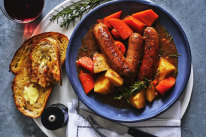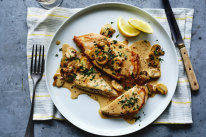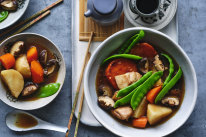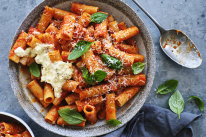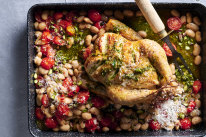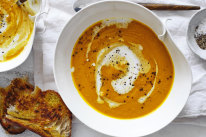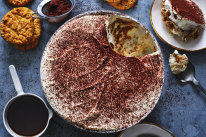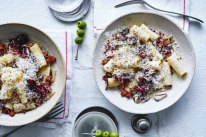Cook Adam Liaw’s juicy version of this cult TikTok chicken dish and prepare to be proposed to
Would this new and improved Marry me chicken recipe prompt someone to propose to you? Try it on a loved one and find out for yourself.
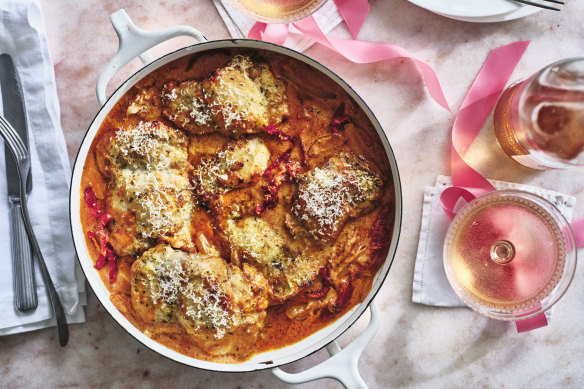
According to social media platform TikTok, this tomato-rich chicken stew will cause the person you make it for to marry you. Trouble is, the viral recipe uses chicken breasts, almost guaranteeing dry, stringy results. So here’s my version, reworked as a creamy, juicy braise you can serve for a midweek dinner or a date night at home.
Ingredients
6 chicken thigh fillets
salt and black pepper, to season
2 tbsp plain flour
1 tsp dried thyme
2 tbsp olive oil
2 brown onions, sliced
4 garlic cloves, sliced
200g sun-dried tomatoes, sliced
150ml tomato passata
1 tsp chicken stock powder
300ml thickened cream
1 cup grated parmesan
a handful of basil leaves, to serve
Method
Step 1
Heat the oven to 180C fan-forced (200C conventional). Season the chicken well with salt and pepper and toss with the flour and thyme.
Step 2
Heat a heavy ovenproof pan over medium heat. Add the oil and fry the chicken until lightly browned. Add the onion and garlic around the chicken and fry for about 3 minutes until the onion is starting to take on some colour.
Step 3
Add the sun-dried tomatoes, passata, chicken stock powder and cream, and stir to combine and bring to a simmer.
Step 4
Sprinkle the parmesan over the top, then transfer the pan to the oven and bake for 20 minutes, uncovered, until the chicken is cooked through and the sauce has thickened and reduced. Scatter with the basil leaves to serve.
The ‘Marry me chicken’ backstory
I’ve made no secret of the fact that I think viral recipes are, almost without exception, complete garbage. This is mainly because they have nothing to do with food, nor quality, nor, ironically, even popularity.
Open your social media app of choice these days and you’ll be assaulted by folks of varying cooking ability gurning at the camera as they slap ingredients down on chopping boards with speed and force and hiss at you about the latest “viral” recipe they’re copying from some other foodslap content creator.
Virality in the online world is driven by algorithms, and algorithms don’t care how your food tastes, how much it costs, whether it’s easy to make, or whether it’s even edible at all. The key ingredient for a viral recipe is engagement, and that can be both positive and negative.
There are many ways to drive engagement. One of the most effective is “negging”, where a video will tell you that something you’ve been doing your whole life – like peeling a banana – is “wrong” and you’re an idiot for peeling a banana like a normal person. Then psychology takes over, and you suddenly find yourself indignantly watching the video just so you can prove that you’re not an idiot after all.
Another is “hacking”, where a video will promise that they’ve discovered a secret shortcut, like slicing a mango by pushing it on the edge of a wine glass, even though that is quite possibly the stupidest imaginable way of slicing a mango.
Algorithms don’t care about stupidity. In fact, they relish it. If thousands or millions of people hate-watch the banana peeling or mango slicing video and better yet, comment to tell the foodslapper how impossibly idiotic their method is, that’s all engagement, baby!
But then phase two of the virality spiral begins because millions of foodslappers who have seen the sweet, sweet engagement that the initial (very stupid) video produced become desperate for a taste of that engagement and make their own videos promising to try out the hack from the previous video because the all-powerful algorithm is now prioritising videos of stupid banana peeling.
Now millions of people are watching banana-peeling videos even though everyone already knows how to peel a banana and nobody is planning on actually changing the way they peel a banana anytime soon. Then we just repeat the cycle with everything from baking dry pasta with feta and mixing peanut butter into instant noodles to smashburger tacos and butter boards until all food is meaningless, nothing matters any more, and we sink slowly into the abyss.
So imagine my surprise, then, when my editor wrote to me asking if I’d seen “the “Marry me chicken recipe that went viral on TikTok” with the added qualification, “It looked horrendous.”
I hadn’t, but anyway… *record scratch*… that’s how I ended up here, writing to you about a viral recipe from TikTok.
The premise of Marry me chicken is that this dish, if made correctly, will cause the person you make it for to marry you [citation needed].
Story aside, the TikTok dish begins with a veloute made with tomato paste and chicken stock, which is then used to braise chicken breasts, before being finished with cream and sun-dried tomatoes.
‘Let me say unequivocally, no good can come of braising chicken breast.’
There’s a lot to unpack here, but let me start with the obvious negative. Almost all viral videos come out of America, which happens to be the country that is most responsible for ruining food globally. One of America’s major food crimes is its absurd predilection for braising chicken breast.
I’ve seen more than a few American viral videos that spruik the “hack” of shredding your completely dry, stringy, braised-to-death chicken breast by using electric hand beaters. I’ll pause here for a moment so you have time to stop screaming.
Let me say unequivocally, no good can come of braising chicken breast. It can be poached to retain its natural moisture, but braising it is a recipe for disaster, which is to say, a recipe for viral American food. Literally any other cut of chicken – thigh fillets, wings, drumsticks, or cutlets on the bone – would be a better choice.
That said, beyond the chicken breast and the transparently false story that led to its virality, I surprisingly don’t mind Marry me chicken as a recipe. It’s just a variation of Tuscan chicken, an old favourite, although not actually from Tuscany.
There are some ways that it could be made a little better and more simply, but I particularly like the fact that it is playing to my years-long efforts to bring sun-dried tomatoes back into mainstream use.
So here’s my version of Marry me chicken. I use tomato passata instead of paste, skip the veloute, add onions, and of course, replace the chicken breast for thigh fillets.
I hope you enjoy it, and I hope it brings you all the love you desire this Valentine’s Day.
Appears in these collections
- 14 simple dinners that go straight to the sauce
- Eat and repeat: 10 warming new recipes to put on high rotation
- The 20+ top recipes of February – starring the viral chicken dish Adam Liaw hates to love
- 14 Adam Liaw recipes you’ll want to put on high rotation immediately
- Every new recipe of the summer (starring the cheesy chicken traybake you’ll love through autumn, too)
The best recipes from Australia's leading chefs straight to your inbox.
Sign up- More:
- One-pot
- Chicken
- Onion & leek
- Tomato
- Cream & milk
- Egg-free
- Nut-free
- Italian
- American
- Casseroles & braises
- Main course
- Entertaining
- Valentine's Day
- Dinner party
- Father's Day
- Comfort food
- Midweek dinner
- Quick & easy
- Family meals
- TikTok

